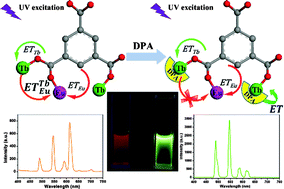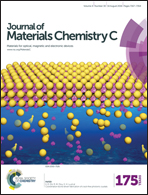A nanoscaled lanthanide metal–organic framework as a colorimetric fluorescence sensor for dipicolinic acid based on modulating energy transfer†
Abstract
A promising strategy using bimetallic Tb/Eu-MOFs as a fluorescence ratio sensor for Bacillus anthracis detection is reported in this work. The nanostructured Tb/Eu-MOFs have been synthesized through rapid and direct precipitation at room temperature. The energy transfer from Tb3+ to Eu3+ in this system is observed and studied. As a unique biomarker of Bacillus anthracis, dipicolinic acid (DPA) can readily combine with Tb3+ by replacing the coordinated water and enhance the green fluorescence emission of the MOF. The bimetallic MOF possesses two luminescent centers in one system, which can facilitate self-calibration without the requirement for any instrument-specific calibration. More interestingly, after introducing the appropriate concentration of DPA, the emission color of Tb/Eu(BTC) changes from red-orange to yellow-green, which can be observed by the naked eye. This luminescence color variation is caused by the transformation of the energy transfer process in the MOF. The nano-sized bimetallic Tb/Eu-MOFs is further employed to detect DPA in human serum and the results are in agreement with their standard additions in an acceptable recovery range. The combined merits of high selectivity, good reproducibility, rapid and naked-eye recognition of DPA make Tb/Eu(BTC) a promising material for application in the convenient detection of Bacillus anthracis.


 Please wait while we load your content...
Please wait while we load your content...